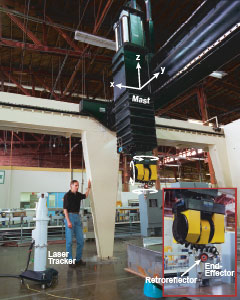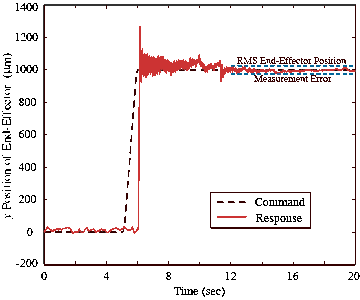Adaptive Pulse Width Control of Structurally Flexible Systems
Project Summary
The performance of manufacturing machines of all sorts depends upon precise control of the position of some sort of end-effector. Mechanical friction, and in particular stiction, has forever been a thorn in the side of the developers of such machines.
A 1988 publication by researchers at the University of California at Berkeley describes a remarkably effective algorithm for point-to-point control of the position of a rigid-body plant that is subject to mechanical friction, including stiction. This Pulse Width Control (PWC) algorithm is applied only when the actual position is close enough to the desired position that stiction forces come into play. The PWC algorithm applies a series of fixed-height rectangular force pulses, in a feedback fashion, to move the plant to its desired position. For point-to-point position control, under mild assumptions regarding the accuracy of the values assumed for the plant parameters, including the Coulomb friction and stiction levels, limit-cycle-free operation and zero steady-state position error are guaranteed.
This project’s Principle Investigators have investigated PWC applied to flexible-body plants. They have shown that when the Berkeley PWC algorithm is applied to control the position of the end-effector of a flexible-body plant, the result can be a position-error limit cycle. They have furthermore shown that this limit cycle can be avoided, and that zero steady-state end-effector position error can be achieved, by use of a piecewise-linear-gain (PLG) PWC law. When applied to a six-axis industrial robot, their PLG PWC law achieved a more than order-of-magnitude improvement in point-to-point end-effector position control accuracies compared to what could be achieved with proportional-integral-derivative controllers.
This project seeks to extend their earlier PWC work to the extent that this same order-of-magnitude improvement in point-to-point end-effector position control accuracy will be obtainable in industrial robots and machine tools that operate in bona fide industrial settings. To accomplish this they will undertake two developments. First, they will develop an adaptive version of their PLG PWC law. This adaptive PLG PWC law will adapt its parameters to changes in the dynamics, including the Coulomb friction and stiction levels, of the plant that is being controller. And second, they will extend their PLG PWC law design methodology, the present version of which relies upon weak dynamic coupling between all pairs of drive axes, to make it applicable to plants having multiple drive axes that are strongly dynamically coupled.
Intellectual Merit: The use of PLG PWC laws for precise point-to-point end-effector position control was pioneered by this project’s Principal Investigators. The extensions of their earlier PWC work to be completed in this project constitute unique and essential additions to their earlier PWC work—additions that will dramatically increase the interest, within the control system design community, in the PWC approach to point-to-point end-effector position control.
Broader Impacts: The expectation of our society is unmistakably that, as time marches on, manufacturing machines will be capable of manufacturing parts to dramatically more exacting standards. The only hope for meeting this expectation is for manufacturing machines to take advantage of the remarkable rate of innovation that is evident in two areas today, namely instrumentation and computing. This project will dramatically demonstrate what can be accomplished when expertise in dynamic system analysis and control system design plus the latest in instrumentation and computing technologies are focused on dramatically improving the accuracy of point-to-point end-effector position control that can be achieved with industrial robots and machine tools. And finally, the broader impacts of this project will be significantly enhanced by the fact that it will be performed by a team of researchers from a predominantly undergraduate institution (Bucknell University) and a Research I institution (the University of Washington).

